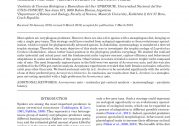Obsah
Most spiders are euryphagous predators. However, there are also a few species with a stenophagous diet, foraging on only a single prey taxon. This strategy could have resulted from ecological opportunity or from evolutionary specialization, which is typical for phylogenetically advanced species. In Zodariidae, myrmecophagy is considered a derived trophic strategy. Therefore, the main objective of this study was to investigate the trophic ecology of Leprolochus birabeni (Zodariidae), whose rather basal position in the phylogeny predicts euryphagy. We studied the realized niche (potential and actual prey) and the fundamental niche (capture success), capture efficiency and behavioural adaptations in males and females of this species. Observations in nature revealed a narrow trophic niche composed only of ants. The most frequently captured prey in the field were two species of Acromyrmex ants, and this was also confirmed in the DNA gut content analysis. Acceptance experiments revealed that both females and males refused to catch prey other than ants. We found nocturnal activity in L. birabeni to be correlated significantly with the activity of one of their preferred prey, Acromyrmex lobicornis. In conclusion, our results show that L. birabeni is a stenophagous ant-eating specialist with a high preference for Acromyrmex ants.



